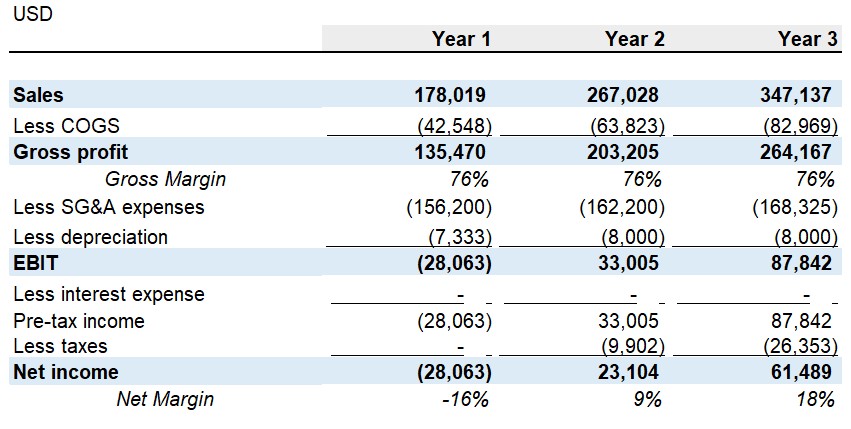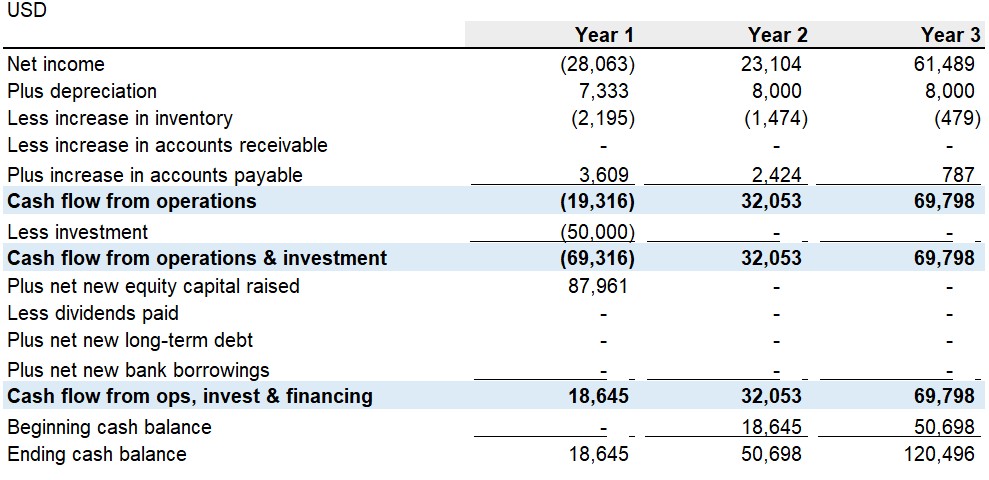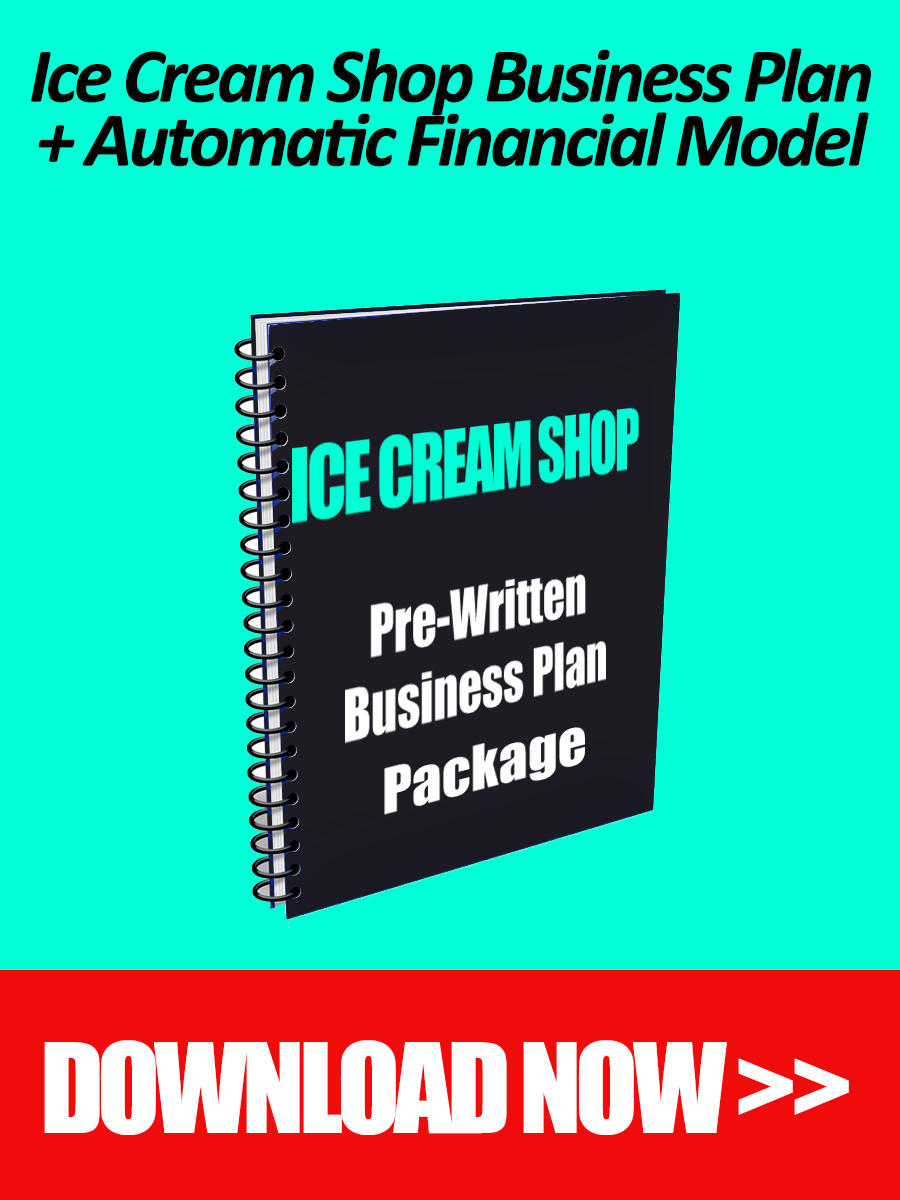Whether you’re a passionate ice cream connoisseur or an aspiring entrepreneur, creating a detailed ice cream shop financial plan is a crucial step in the business planning process. A well-crafted financial plan not only provides a roadmap for your ice cream shop’s success but also offers a comprehensive understanding of its financial health and growth potential.
As a seasoned business planner with over 15 years of experience, I have assisted many F&B entrepreneurs in successfully planning and launching their ice cream ventures and I am here today to share with you useful tips and advice to help you build a robust financial plan.
In this detailed guide, we will explore the essential components of an ice cream shop financial model, but first let’s have a look at the main benefits of this exercise.
Ice Cream Shop Financial Plan Template in Excel
Before we start, I wanted to briefly introduce our ready made automatic ice cream shop financial spreadsheet in Excel. It comes as part of our premium Ice Cream Shop business plan package. This is a very cost-effective solution that allows you to create an investor-grade financial model and business plan tailored to your own Ice Cream project in record time. Check it out below.
The Benefits of Building a Financial Plan
Creating a financial plan for your ice cream shop offers several important benefits. Firstly, it provides a clear overview of your anticipated costs, revenue, and profitability. This knowledge enables you to set realistic financial goals, establish pricing strategies and evaluate your shop’s performance against predetermined benchmarks.
Additionally, a well-developed ice cream shop financial plan helps you make informed decisions about resource allocation. You can accurately project your expenses, such as ingredients, equipment, employee wages, utilities, and marketing efforts. By estimating and monitoring these costs, you can effectively manage your cash flow and maintain a healthy financial position.
A financial plan also plays a critical role in attracting potential investors or securing loans from financial institutions. Investors and lenders will want to see a well-structured plan that demonstrates your understanding of the ice cream industry, market demand, and growth opportunities. It provides them with the necessary confidence in your ability to generate profits and repay any borrowed funds.
Furthermore, an ice cream shop financial plan allows you to identify potential risks and develop contingency measures to mitigate them. By conducting financial projections and scenario analyses, you can assess the impact of various factors such as changing market conditions, pricing strategies, or unforeseen expenses. This proactive approach helps you stay prepared and adapt to evolving circumstances, ultimately increasing your ice cream shop’s chances of long-term success.
In the following sections, we will delve into the key components of a comprehensive financial plan for an ice cream shop. We will explore cost forecasting, capital expenditures, revenue forecasting, income statements, cash flow forecasting, and balance sheet forecasting. By the end of this article, you will have a solid foundation to build your own detailed financial plan, tailored to your ice cream shop’s unique requirements.
Ice Cream Shop Cost Forecast
Building a cost forecast involves estimating and projecting the expenses associated with various aspects of your business operations. A thorough cost forecast allows you to anticipate and plan for both fixed and variable costs, providing you with a clear understanding of your financial obligations.
Start-up Costs
When launching your ice cream shop, there will be several one-time expenses to consider. These start-up costs typically include:
- Lease or purchase of a physical location
- Renovations and interior design
- Licenses and permits
- Initial inventory of ingredients and supplies
- Equipment purchases (e.g., ice cream machines, freezers, display cases). More on that in a later section.
- Point-of-sale systems and technology
- Marketing and advertising expenses
- Legal and professional fees (e.g., business registration, consulting)
It is key to research and obtain accurate cost estimates for each item in your start-up cost forecast. Consider reaching out to suppliers, contractors, and industry experts to gather relevant pricing information.
Operating Costs
Operating costs are the ongoing expenses required to run your ice cream shop on a day-to-day basis. These costs can be categorized into two main types: fixed and variable.
Fixed Costs
Fixed costs remain relatively stable regardless of your ice cream shop’s sales volume. Examples of fixed costs include:
- Rent or mortgage payments
- Utilities (electricity, water, gas)
- Insurance premiums (property, liability)
- Salaries and wages (non-variable portion)
- Subscription fees (software, services)
Variable Costs
These costs fluctuate based on your shop’s sales volume or production levels. These costs can include:
- Cost of ingredients (dairy, fruits, cream, flavors, toppings)
- Packaging materials (cups, cones, spoons)
- Direct labor costs (staff wages directly involved in production or serving)
- Marketing and advertising expenses (can vary depending on promotions or campaigns)
- Commissions (if applicable, for sales representatives)
- Credit card processing fees
To estimate your variable costs, you may need to consider historical data, industry benchmarks, or supplier quotes. It’s important to regularly monitor and update these costs as your ice cream shop grows and experiences changes in sales volume or market conditions.
Overhead Costs
Overheads are the expenses that are not directly tied to production or sales but are necessary to support your ice cream shop’s overall operations. These typically include:
- Administrative and office expenses (e.g., accounting, legal, office supplies)
- Employee benefits and payroll taxes
- Maintenance and repairs
- Pest control and cleaning services
- Waste disposal
- Professional services (e.g., marketing consultants, IT support)
Contingency Fund
We highly recommend including a contingency fund in your cost forecast to account for unexpected expenses or unforeseen circumstances. Having a reserve fund helps safeguard your ice cream shop’s financial stability and ensures you can handle unexpected challenges without compromising your operations.
When creating your cost forecast, aim to be as accurate and detailed as possible. Consider using our ready-made ice cream financial spreadsheet to save time and effort.
Ice Cream Shop Capital Expenditures
In the context of an ice cream shop, capital expenditures refer to the investments made in long-term assets that are essential for your business operations. These assets typically have a useful life of more than one year and play a crucial role in the production, storage, and delivery of your ice cream products. Developing a capital expenditure plan allows you to anticipate and budget for these significant investments, ensuring the smooth functioning and growth of your ice cream shop.
Equipment and Machinery
Ice cream production and storage rely heavily on specialized equipment and machinery. These capital expenditures usually comprise of:
- Ice cream machines: This includes batch freezers, continuous freezers, or gelato machines, depending on the type of ice cream you plan to offer.
- Refrigeration and storage equipment: Display freezers, walk-in freezers, and refrigerated cabinets are essential for storing and showcasing your ice cream products.
- Mixers and blenders: These are necessary for preparing the ice cream base and incorporating flavors and mix-ins.
- Serving equipment: Soft-serve machines, dipping cabinets, and sundae stations are crucial if you plan to offer various ice cream options to your customers.
Interior Design and Fixtures
Creating an appealing and welcoming ambiance is essential for an ice cream shop. Capital expenditures related to interior design and fixtures usually include:
- Seating arrangements: Chairs, tables, benches, or stools for customers to enjoy their ice cream.
- Counters and displays: Showcases or display cases to present your ice cream flavors and toppings.
- Lighting and decor: Ensure your shop has appropriate lighting and decor that aligns with your brand image.
- Signage and branding: Invest in attractive signage and branding elements both inside and outside your shop.
- Flooring and wall finishes
- Plumbing and electrical work
- HVAC systems and ventilation
- Kitchen setup and plumbing for sinks and equipment
Consider consulting with interior designers or shop fitters to get accurate cost estimates for your desired interior design and fixtures. These expenses are often underestimated in the planning phase so make sure to add some extra budget as a contingency.
Vehicles and Delivery Systems
If you plan to offer delivery services or operate multiple locations, you may need to invest in vehicles or delivery systems. Capital expenditures related to vehicles and delivery systems may include:
- Delivery vehicles: Vans, trucks, or bikes depending on the scale of your operations.
- Delivery systems: Customized packaging, insulated containers, or delivery software.
Technology and Software
In the modern business landscape, technology and software play a crucial role in managing operations, sales, and customer experience. Here are typical examples relevant to the ice cream shop business:
- Point-of-sale (POS) systems: Invest in reliable, user-friendly POS systems that integrate inventory management, sales tracking, and reporting functionalities.
- Accounting and financial management software: Consider using specialized software to streamline your bookkeeping, budgeting, and financial analysis processes.
- Online ordering and delivery platforms: If you plan to offer online ordering or delivery services, invest in user-friendly and efficient platforms to handle these operations.
- Customer relationship management (CRM) systems: Use CRM software to manage customer data, preferences, and loyalty programs.
Ice Cream Shop Revenue Forecast
Developing a revenue forecast allows you to estimate and project the sales and revenue your ice cream business is expected to generate over a specific period of time. A well-crafted revenue forecast provides valuable insights into the growth potential of your ice cream shop and helps you set realistic goals for your business.
Define Revenue Streams
Begin by identifying the different revenue streams your ice cream shop will have. These can include:
- Ice cream sales: The primary source of revenue for your shop, which includes various flavors, sizes, and types of ice cream products.
- Toppings and extras: Revenue generated from additional toppings, sauces, cones, sprinkles, or other customizable options.
- Beverages and drinks: If you plan to offer beverages like coffee, milkshakes, smoothies, or specialty drinks, include the expected revenue from these offerings.
- Merchandise or branded products: If you plan to sell branded merchandise like t-shirts, mugs, or ice cream accessories, factor in the revenue generated from these items.
- Catering or events: Some ice cream shops offer catering services or participate in events like parties or weddings.
Sales Volume and Pricing
Estimate the sales volume for each revenue stream based on market research, industry benchmarks, and your specific location and target audience. Consider factors such as foot traffic, local competition, and seasonal variations in demand.
Additionally, determine the pricing strategy for your ice cream products and other offerings. Research the pricing practices of similar businesses in your area to ensure your prices are competitive and aligned with customer expectations.
Sales Channels
Your ice cream shop might rely on different sales channels through which you will generate revenue. These can include:
- In-store sales: The revenue generated from customers who visit your physical location to purchase ice cream.
- Online orders: If you offer online ordering or delivery services, estimate the revenue generated through these channels.
- Catering or events: If you provide catering services or participate in events, consider the revenue generated from these sources.
- Wholesale or distribution: If you plan to supply your ice cream products to other businesses, factor in the revenue generated from wholesale or distribution channels.
Seasonality and Trends
It is important to understand the seasonal variations in demand for ice cream and how they will impact your revenue. Ice cream sales tend to be higher during the warmer months, while colder seasons may see a decline in demand. Factor in these seasonal trends when projecting your revenue and adjust your forecasts accordingly.
Additionally, stay aware of industry trends and customer preferences. Monitor emerging flavors, dietary preferences (such as vegan or lactose-free options), or other popular ice cream trends. Incorporate these trends into your revenue forecast to ensure you can meet customer demands and capitalize on market opportunities.
Ice Cream Shop Income Statement Forecast
An income statement, also known as a profit and loss statement, provides a snapshot of your ice cream shop’s financial performance by summarizing revenues, expenses, and resulting net income or loss over a specific period. Developing an income statement forecast is essential for understanding your shop’s profitability and value creation potential. Here’s how you can create an income statement forecast for your ice cream shop:
Revenue/Top Line:
Start by listing the different revenue streams you identified in the revenue forecast section. Estimate the expected sales volume and the corresponding revenue for each stream. Consider factors such as pricing, sales channels, and seasonality. Summarize the total revenue at the top of the income statement.
Cost of Goods Sold (COGS):
The cost of goods sold represents the direct costs associated with producing the ice cream products sold. This includes the cost of ingredients, packaging materials, and any other expenses directly related to the production process. Estimate the COGS by considering the quantity of ingredients used, their costs, and any applicable overhead expenses. Subtract the COGS from the revenue to calculate the gross profit.
Operating Expenses:
As seen above, these expenses usually include:
- Rent or lease payments
- Utilities: (electricity, water, gas…etc.)
- Salaries and wages
- Marketing and advertising expenses
- Repairs and maintenance
- Insurance
- Administrative expenses
Depreciation and Amortization:
If you have acquired assets that have a useful life of more than one year, such as ice cream making equipment or vehicles, you should account for their depreciation or amortization. Depreciation represents the gradual decrease in value of tangible assets over time, while amortization applies to intangible assets.
Other Income and Expenses:
Consider any additional sources of income or expenses that may impact your net income. This can include rental income from subletting part of your space or interest income from investments. On the expense side, include any non-operating expenses, such as interest paid on loans or bank fees. Include these amounts separately in the income statement.
Net Income:
Subtract the total operating expenses, depreciation and amortization, and other expenses from the gross profit to calculate the operating income. Then, add any other income and subtract any other expenses to derive the net income before taxes. Finally, consider any applicable tax liabilities and subtract them to arrive at the net income (or loss).
Cash Flow Forecast
A cash flow forecast helps you understand and manage the inflow and outflow of cash in your ice cream business. You can think of cash flows as cash flows from operating activities, investing activities, and financing activities.
A statement of cash flows provides insights into the sources and uses of cash in your business, helping you understand the financial health and liquidity of your ice cream shop. Here’s how you can develop a cash flow forecast:
Cash Flows from Operating Activities:
Cash flows from operating activities reflect the cash generated or used in the day-to-day operations of your ice cream shop. This includes cash flows related to revenue, expenses, and working capital. Consider the following:
- Cash Inflows: Estimate the cash inflows from ice cream sales, online orders, catering services, or other revenue sources identified in the revenue forecast section. Take into account the timing and collection of customer payments (catering will probably differ from in-store customers).
- Cash Outflows: Account for the cash outflows associated with operating expenses, such as the cost of ingredients, wages and salaries, rent, utilities, marketing expenses, and other operating costs. Consider the timing of payments to suppliers, employees, and service providers.
- Working Capital: Factor in changes in working capital items, including accounts receivable (customer payments), accounts payable (vendor payments), and inventory. A decrease in accounts receivable or inventory can generate cash inflows, while an increase in accounts payable may result in cash outflows.
Calculate the net cash flow from operating activities by subtracting the cash outflows from the cash inflows. This figure indicates the operational cash flow generated or used by your ice cream shop.
Cash Flows from Investing Activities:
Cash flows from investing activities represent the cash used for investments in long-term assets and the cash generated from the sale of assets. Here are key elements to keep in mind:
- Capital Expenditures: Account for the cash outflows related to acquiring equipment, machinery, vehicles, or any other capital assets essential for your ice cream shop. These were detailed in the capital expenditures section.
- Asset Disposals: If you plan to sell any assets, estimate the cash inflows resulting from these sales.
- Other Investments: Include any cash outflows or inflows resulting from investments in other businesses or financial instruments.
You can calculate the net cash flow from investing activities by subtracting the cash outflows from the cash inflows.
Cash Flows from Financing Activities:
Cash flows from financing activities reflect the cash generated or used through financing activities, including borrowing or repaying debt and equity transactions. Here are the main components to remember:
- Debt Financing: Account for the cash inflows from loans or credit lines obtained to support your ice cream shop’s operations. Include any principal repayments made during the forecast period.
- Equity Financing: Compute the cash inflows resulting from equity investments made in your ice cream shop. This can include contributions from owners or investors.
- Dividends or Distributions: If your ice cream shop distributes profits to owners or investors, then you need to account for the cash outflows resulting from dividend payments or distributions.
You can compute the net cash flow from financing activities by subtracting the cash outflows from the cash inflows.
Finally, summarize the net cash flows from operating activities, investing activities, and financing activities to determine the overall change in cash for each period. You can analyze the resulting net cash flow to assess the liquidity and financial health of your ice cream shop. Positive net cash flow indicates cash surplus, while negative net cash flow indicates cash deficit.
Balance Sheet Forecast
The balance sheet forecast allows you to anticipate the assets, liabilities, and owner’s equity that will shape your business’s financial standing. Here’s how you can create a solid balance sheet forecast for your ice cream shop:
Assets:
Start by identifying and estimating the different categories of assets your ice cream shop will have. These usually include:
- Current Assets: Estimate the value of assets that are expected to be converted into cash or used up within one year, such as cash on hand, accounts receivable (customer payments), and inventory (ice cream, toppings, and other supplies).
- Fixed Assets: This is the value of long-term assets, such as equipment, machinery, vehicles, and furniture used in your ice cream shop. Don’t forget to include any depreciation or amortization expenses accounted for in the income statement forecast.
- Other Assets: Account for any other assets your ice cream shop may have, such as investments, prepaid expenses, or intangible assets like trademarks or licenses.
Liabilities:
Liabilities typically include:
- Current Liabilities: These are liabilities that are expected to be settled within one year, such as accounts payable (vendor payments), accrued expenses (wages, utilities), and short-term loans or credit lines.
- Long-Term Liabilities: These liabilities have a repayment period longer than one year, such as long-term loans or mortgages.
Estimate the value of each liability category based on outstanding balances, payment terms, and any interest or principal repayments planned during the forecast period.
Owner’s Equity:
Owner’s equity (or shareholder’s equity) represents the residual interest in the assets of your ice cream shop after deducting liabilities. It reflects the ownership interest of the business owner (or owners). Consider the initial investments made by the owner(s) and any additional contributions or withdrawals during the forecast period. You can estimate the owner’s equity by calculating the difference between total assets and total liabilities.
Ensure that the balance sheet follows the fundamental accounting equation: Assets = Liabilities + Owner’s Equity. Adjust the estimates of assets, liabilities, or owner’s equity if necessary to maintain this balance.
Conclusion
In the process of writing a business plan for your ice cream shop, developing a detailed financial plan is essential. It provides a clear roadmap for understanding the costs, investments, revenues, expenses, and financial position of your business.
Creating a financial plan allows you to assess the feasibility of your ice cream shop, allocate resources effectively, and make informed decisions to achieve financial success. It helps you anticipate and manage costs, plan for necessary expenditures, forecast revenue streams, track profitability, ensure healthy cash flow, and evaluate your overall financial position.
By regularly reviewing and updating your financial plan, you can adapt to changing circumstances, address challenges, and capitalize on opportunities. It also serves as a valuable tool for communicating with potential investors or lenders, instilling confidence in your ice cream shop’s financial viability.
If you wish to save on time and money while building a financial plan in record time, we highly recommend you download our automatic financial plan spreadsheet included in our ready-made ice cream shop business plan template. Our cost-effective solution is easy to use and will allow you to create an investor-grade ice cream shop business plan with detailed financials within a few hours.









